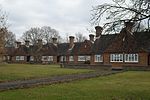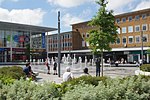Brewery Shades
Buildings and structures in CrawleyCommercial buildings completed in the 15th centuryGrade II listed pubs in West Sussex

The Brewery Shades is a public house on the High Street in Crawley, a town and borough in West Sussex, England. The building, which stands on a corner site at the point where the town's ancient High Street meets the commercial developments of the postwar New Town, has been altered and extended several times; but at its centre is a 15th-century timber-framed open hall-house of a type common in the Crawley area in the Middle Ages. Few now survive, and the Brewery Shades has been protected as a Grade II listed building.
Excerpt from the Wikipedia article Brewery Shades (License: CC BY-SA 3.0, Authors, Images).Brewery Shades
The Broadwalk,
Geographical coordinates (GPS) Address Nearby Places Show on map
Geographical coordinates (GPS)
| Latitude | Longitude |
|---|---|
| N 51.1156 ° | E -0.1899 ° |
Address
The Broadwalk
The Broadwalk
RH10 1HJ
England, United Kingdom
Open on Google Maps











